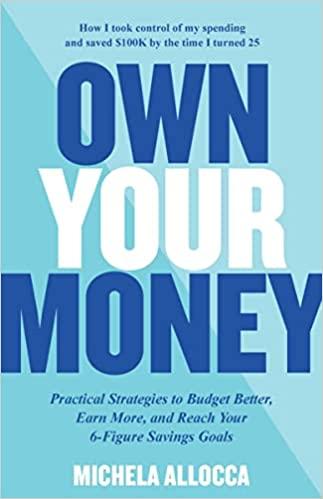Question
. NEED NEW ANSWER ASAP / ANSWER NEVER USED BEFORE A retailer wants to put items on sale and wants to know the impact on
.
NEED NEW ANSWER ASAP / ANSWER NEVER USED BEFORE
A retailer wants to put items on sale and wants to know the impact on profit if the selling price of those items are reduced by 25%. To assist the retailer, provide a detailed example of CVP analysis using the original sales price and then do a "what if analysis if the retailer sold 100 more items at the lower price. Do you think your analysis would show the same impact on profit for both the companys online and brick and mortar stores keeping in mind the idea of variable and fixed costs? Why or why not?
---------------------------------------------------------
Please see Escoto's post below yours. You want a post with several paragraphs
-----------------------------------------
A Cost Volume Profit (CVP) analysis works through a contribution income statement. Cost Volume Profit analysis is a necessary tool for forecasting and management control (BUAN & DINA, (2009). The components required to contribution income statements are sales, the variable cost, contribution margin, fixed cost, and net operating income. In the contribution income statement, numbers are expressed in totals and per unit basis (Noreen, Brewer & Garrison, 2020). Our sales are the total price the item is sold for times the number of items sold. Sales = Selling price per unit X Quantity sold. After understanding your total sales, you then subtract your variable cost from your sales. It is instrumental in understanding your variable cost per unit to multiply your variable cost per unit times your quantity of items sold. Your total sales minus your total variable cost equal to your contribution margin. Your contribution margin is the profit made out of the item sold without deducting your fixed cost per unit.
The contribution margin does not account for fixed expenses. The contribution margin per unit is what you make out of each item sold after variable cost, which incurs directly with the product. You will subtract your total fixed cost from your total contribution margin to know your net operating income, aka profit. Profit = (Selling price per unit X quantity sold) (Variable expenses X quantity sold) Fixed expenses (Choo & Tan, (2011). It is essential to know your contribution margin per unit. After you have sold enough to cover your fixed costs, your contribution margin per unit tells you exactly how much profit you make out of each item sold after the break-even point. Only after a certain total amount of items sold are all fixed costs and variable costs covered, and then the company can be profitable. The formula would be profit = (contribution margin per unit X quantity) fixed expenses.
If Acoustic Concepts regularly sells (400 speakers) a month and we increase the total units sold by 100, the company sells 500 speakers a month. If we reduce the price per unit by 25% from the regular $250 each speaker cost, each speaker will sell for $187.50. It would negatively impact the profitability of the company significantly. The total sales would be 500 x 187.50 = $93,750. If we sold only $400 at $250 each, the total sales would be $100,000. Also, taking into account the variable cost per unit is $150, and we sell the unit for $187.50, our contribution margin is only $37.50 per item, instead of the $100 without the 25% reduction in price that would come off the profit, not the variable cost. Our total variable cost would be 500 units x $150 = $75,000 + fixed expenses at $35,000 = $110,000. If our total sales are $93,750 and our total expenses are $110,000, we have a deficit of (-$16,250). The increased sales of 100 units at a 25% reduction in price per item was a horrible idea.
Suppose the fixed cost in the bricks and mortar store is $35,000, and we are selling the speakers at a 25% reduction in price. In that case, we are unprofitable, however, say we were selling the item at the 25% reduction and yet still selling 100 units more. However, our fixed cost was different because we sold online and had a different cost structure, and instead of the $35,000 fixed cost, our fixed cost was only $10,000. In this scenario, we would be profitable at $8,750.
Sales Volume/Units Sold
400speakers 500speakers Per Unit
Sales (@ $250 per speaker) $100,000 $250
Sales (@ 25% reduction $187.5) $93,750 $187.50
Variable expenses ( @ $150 per speaker) $60,000 $75,000 $150
Contribution Margin @ $250 $40,000 $100
Contribution Margin @ 187.50 @ -25% $18,750 $37.50
Fixed Expenses $35,000 $35,000
Online Fixed Expenses* $10,000*
Net Operating Income $5,000 (-$16,250)
Net operating income online* $8,750*
_________________________________________--
I need a similar answer to above please.
COPY AND PASTE Answer in paragraph form, and no picture attachment please. No bullet points
ANSWER THROUGHLY 1 page
*************NEEDS TO BE AN ORIGINAL SOURCE ANSWER NEVER USED BEFORE************
PLEASE ANSWER THROUGHLY ALL ANSWERS
Step by Step Solution
There are 3 Steps involved in it
Step: 1

Get Instant Access to Expert-Tailored Solutions
See step-by-step solutions with expert insights and AI powered tools for academic success
Step: 2

Step: 3

Ace Your Homework with AI
Get the answers you need in no time with our AI-driven, step-by-step assistance
Get Started


